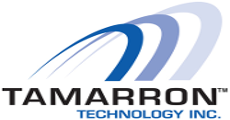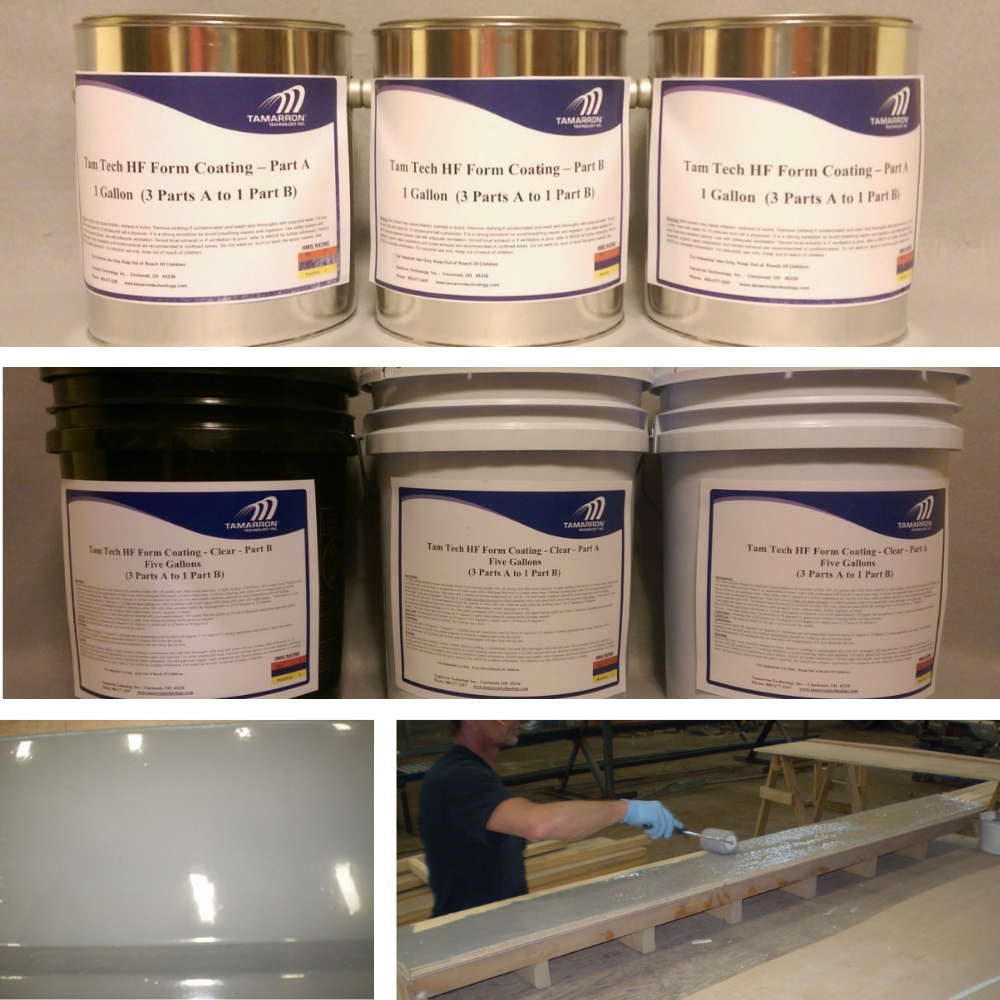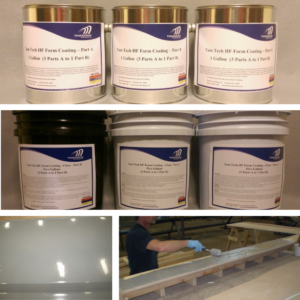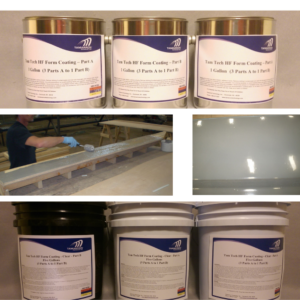Epoxy Coating For Protecting Concrete Forms – Low Temp
Tam Tech HF Form Coating – Low Temp is a two component, fast setting, low odor epoxy coating designed for protecting all types of concrete forms at colder temperatures. It greatly extends the life of wood, metal and concrete forms and tremendously improves the concrete finish. Tam Tech HF Form Coating is ideal for pre-cast and cast-in-place applications providing a hard, durable surface to protect the forms. It is a 100% solids epoxy that does not require a primer.
Product Features:
- Greatly extends the life of wood and metal forms
- Fast setting, designed for colder temperatures
- Tremendously improves the concrete finish “architectural quality”
- Easy clean-up between castings
- Hard, durable protective coating
- Bonds to wood, steel, Styrofoam and concrete
- Replaces fiberglass or urethane coatings
- Bonds to damp forms
- Zero solvents or VOC’s
Instructions:
The form surfaces should be clean and sound. Remove all concrete residue, dirt, oil, grease, and other loose materials. A light sanding of the forms will increase bond. Surfaces can be cleaned with a solvent wipe or an application of warm water with a detergent followed by a warm water rinse. Continue cleaning until water will no longer bead up on the forms. Remove all standing water. Then clean with a vacuum or oil-free compressed air. Let dry. Tam Tech HF Form Coating will not bond to a dirty surface. For best results condition material to room temperature prior to mixing. Premix part A and part B separately. Then mix at a 2-1 ratio for three minutes in a third container with a low speed drill (about 600 rpm) and a jiffy mixer. Do not use high speed mixing, it will whip air into the material. The mixed material should be uniform in color. Mix only what can used within the working time of 20 -25 minutes at 50 degrees F. Then immediately pour the material onto the forms and spread with a trowel, brush, squeegee or a short nap epoxy roller. With a roller, only roll the material once to avoid trapping air in the coating. Recommended application thickness is 15 mils. One gallon of material will cover about 80 – 120 square feet per gallon at 15- 20 mils of thickness depending upon the surface texture. Then after initial cure, apply form release to coating before pouring concrete.
Technical Data:
- Mix Ratio: 2 to 1
- Color: Clear when mixed (Colors available)
- Solids: 100%
- Consistency: pourable
- VOC Content: 0 g/L
- Working Time: 20-25 minutes at 50 degrees F
- Initial Cure:10 – 12 hours at 50 degrees F, 21 – 30 hours at 35 degrees F
- Compressive Strength: ASTM D-695: 11,100 psi Shore D Hardness: ASTM D-2240: 81-85
- Abrasion Resistance: ASTM D-4060: .28 mg loss after
- 1000 cycles
- Impact Resistance: MIL D-24613: No cracking or delamination
Limitations: Substrate and air temperature must be above 35 degrees F (2 degrees C) during application and during curing. Check the relative humidity and the dew point. The surface temperature should be 6 degrees above the dew point. Store product above 50 degrees F (10 degrees C) if possible. High temperatures will accelerate the set time and cold temperatures will slow down the set time.
Shelf Life & Storage Temperature: Two years in unopened containers stored at 50 to 90 degrees F (10 to 32 degrees C)
Coverage: One gallon of material will cover about 120 square feet per gallon at 15 mils of thickness depending upon the surface texture. This is an estimate only. Some customers apply at a heavier rate of application.
Clean Up: Clean material before it sets up. Use a solvent like xylene.
Packaging: 3 gallon kits (3-1 gallon cans);15 gallon units (3-5 gallon pails) and 165 gallon units (3-55 gallon drums)
Cure Time:Working time is 20-25 minutes at 50 degrees F. Initial cure is 10 – 12 hours at 50 degrees F and 21 – 30 hours at 35 degrees F
Warning: Skin contact may cause irritation, redness or burns. Remove clothing if contaminated and wash skin thoroughly with soap and water. For eye contact, flush with water for 15 minutes and call a physician. It is a strong sensitizer so avoid breathing vapors and ingestion. Use safety glasses and wear chemical resistant gloves. Use with adequate ventilation / forced local exhaust or if ventilation is poor, refer to SDS for further information. NIOSH approved, organic vapor respirators and forced exhaust are recommended in confined areas. Do not weld on, burn or torch the epoxy material. See SDS for complete information. For industrial use only. Keep out of reach of children.




Reviews
There are no reviews yet.